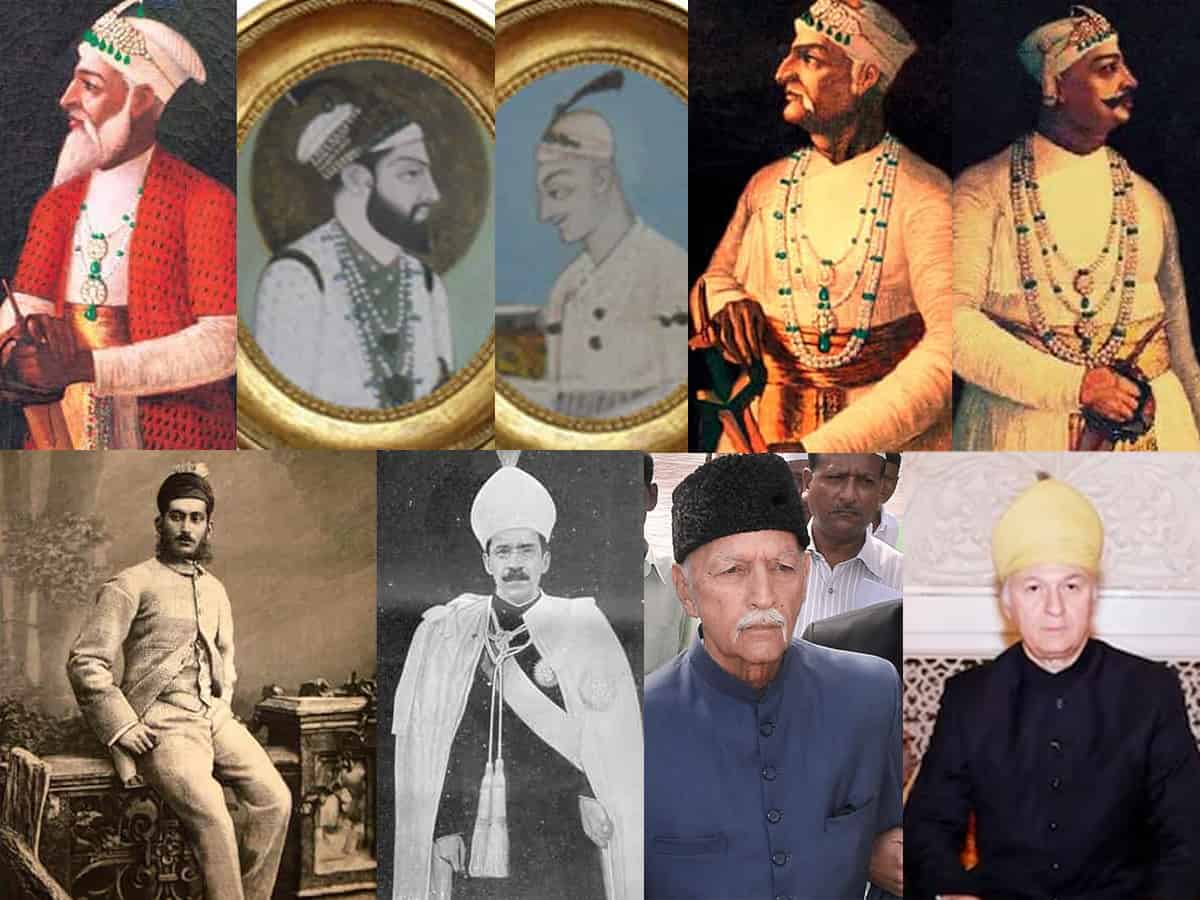
Ever since the death of Prince Mukarram Jah on 14th January 2023, who was considered the last and titular Nizam, Hyderabad’s Nizams, the rulers of the Asaf Jahi dynasty are in the news on every tabloid, newspaper and news channel. A lot is being debated about the Nizams from their lineage to titles to connections to inheritance.
Let us understand their lineage and the use of the title Nizam-ul-Mulk Asaf Jah. Basing my views on Henry George Briggs book The Nizam: His History and Relations with the British Empire published in 1861 and Roper Lethbridge’s book The Golden Book of India: A Genealogical and Biographical Dictionary of the Ruling Princes, Chiefs, Nobles, and Other Personages, Titled or Decorated, of the Indian Empire, with an appendix for Ceylon, published in 1893, when we look at the remote ancestry of the Nizams, their lineage is traced to two lines of descent.
The first line of descent is from Shaikh Shah Abudin Suharwardi, a lineal descendent of Caliph Abu Bakr, the father-in-law, of Prophet Muhammad. Shaikh Shah Abudin Suharwardi who lived in Persia was a contemporary of the Persian poet Sadi and finds reference in his thirteenth century poetic composition, Bostan, as his murshad or spiritual guide. It is believed that some of the immediate descendants of the shaikh settled in Turkey and also some of them travelled to Samarqand, and became ulema there. The popular ulema from this line were Khwaja Ismail, his son Khwaja Abid who later on was designated as Qazi and Shaikh-ul-Islam.
The second lineage of the Nizams of Hyderabad’s ancestry is traced to the family of Tartars and claim descent from Bahauddin who was the founder of the Naqshbandi Sufi silsilah. Most Naqshbandis prefix the word Khwaja to their names to imply an honourable position of a learned person. Bahauddin was a contemporary of the Turko-Mongol conqueror Timur and his descendent was Khwaja Abid who was the first from the family to visit India. He travelled from Samarqand to Delhi during Mughal emperor Shah Jahan’s reign. Whichever lineage is looked at, we see that Khwaja Abid ultimately travelled to India.
Khwaja Abid was given the title of Sadr-us-Sadr by the Mughal emperor Aurangzeb for his services rendered and was also made the Subedar of Multan. Soon, he was awarded more titles of Azeem Khan and Qillich Khan. Qillich also spelt as Kulij or Qulij in Turkish and Qillich in Persian denoted shamsher, a sword in both languages. Qillich Khan also led campaigns into Bijapur and Golconda during which he was injured badly on his right arm and eventually after battling for his life, he died. He was well-known for his military exploits and was buried at Attapur near Hyderabad in 1686.
Qillich Khan left behind a son, Mir Shahabuddin, born in 1644, who was also later employed by the Mughals. Like his father, he too exhibited exceptional bravery and was awarded by Aurangzeb with the title of Ghaziuddin as he was one of the greatest of the generals of Aurangzeb. For his military and administrative services rendered in the Deccan, he received another title Feroz Jung and Aurangzeb even referred to him as Ghaziuddin Bahadur Feroz Jung Farzand Arjumand meaning dear son.
When Aurangzeb died in 1707, Ghaziuddin was the subedar of Berar and Elichpur. The next Mughal successor, Bahadur Shah, made him the Subedar of Gujarat before the latter died in 1711. Ghaziuddin had married the daughter of Saadaullah Khan, a minister of Shah Jahan, in Delhi and a son had been born to them in 1671 who was named Mir Qamaruddin who came to be known in Deccan’s history as Asaf Jah I.
In 1699, Mir Qamaruddin had received the title of Chin Qilich Khan commanding the imperial troops at Bagul Kota.
He then became Faujdar of the Carnatak at Bijapur and also the Subedar of Bijapur. He was given one of Aurangzeb’s own horses on the battle field in one of the campaigns he led in the Deccan. He remained loyal to Prince Azam but eventually differences arose and they went separate ways. But under Bahadur Shah, he was again invited to the Mughal court and was conferred the Subedari of Oudh and Faujdari of Lucknow with the title Khan-e-Dowran, but soon he was disgusted with the politics at the court and retired by relinquishing all his appointments he was holding under the Mughals.
Next, when Farrukh Siyyar started contesting for the Mughal throne, Chin Qilich Khan was roped in once again and he started to fight on the side of Farrukh Siyyar. He was rewarded in 1713 by Farrukh Siyyar with the title of Nizam-ul-Mulk Asaf Jah and Viceroy of the Imperial Dominions in the Deccan and as Faujdar of Carnatak. He continued to fight against the Marathas for the Mughals. There were a series of rapid developments and conflict with the Syed brothers who had emerged as the king makers to the Mughal throne. This finally led to his independently laying the foundation of his own administration in the Deccan with the battle of Shaker Kheda near Aurangabad in 1724.
Asaf Jah had won battles east, west, north and south, dealt effectively with the kingmaker Syed brothers and successfully established his authority over a vast region that came to be called the Asaf Jahi or Asafiya state.
The title of Asaf Jah was named after the rank of Asaf who was supposed to be a minister of Solomon, the Hebrew king. The title of Asaf was not new; the Mughals had used it many a time earlier. The name Asaf was conferred in Mughal India on Nurjahan’s brother and Mumtaz Mahal’s father and in other instances. It was but natural that the Mughal titles were retained by the nobles of the Deccan. These titles were conferred in ascending order of Jung, Daula, Mulk, Umara or Jah. The British equivalent of Jah or Umara was the English Dukes and Marquesses, Mulk was equivalent to Earl, Daula was equivalent to Viscount, and Jung was like a baron. All the successors of the Nizams have the word Jah appended to their name. The only officer or Prime Minister on whom the title of Jah was conferred was Arastu Jah.
Until the Nizams started ruling independently of the Mughals in the Deccan, they were known as Subedars of the Deccan showing their allegiance to higher authority in Delhi. While the British referred to them out of respect as Nawabs of Hyderabad or Bundagan-e-alee meaning slaves of the highest rank.
Professor Salma Ahmed Farooqui is Director at the H.K.Sherwani Centre for Deccan Studies, Maulana Azad National Urdu University, Hyderabad.

